A sewing machine is a useful part of a textile artist’s toolkit. But with so many brands on the market, how do you decide which is the right machine for you?
The best place to start is to consider what you actually need a sewing machine for.
Are you interested in free machine embroidery or working with water soluble fabric? Stitching appliqué, or creating seams and hems? Or adding texture, quilting and other heavy duty stitching?
The market is changing all the time so, rather than a list of machine models, we thought we’d get some advice from the experts on the best type of machine to buy within your budget.
We talked to five textile artists working in a variety of styles and asked them about the machines they love to use. Free motion embroidery experts Meredith Woolnough and Sue Hotchkis, quilt artist Clara Nartey, and mixed media artists Bobbi Baugh and Katie Essam employ a variety of sewing machines.
Here’s some great guidance from these artists to help you choose and use a sewing machine for your textile art adventures.
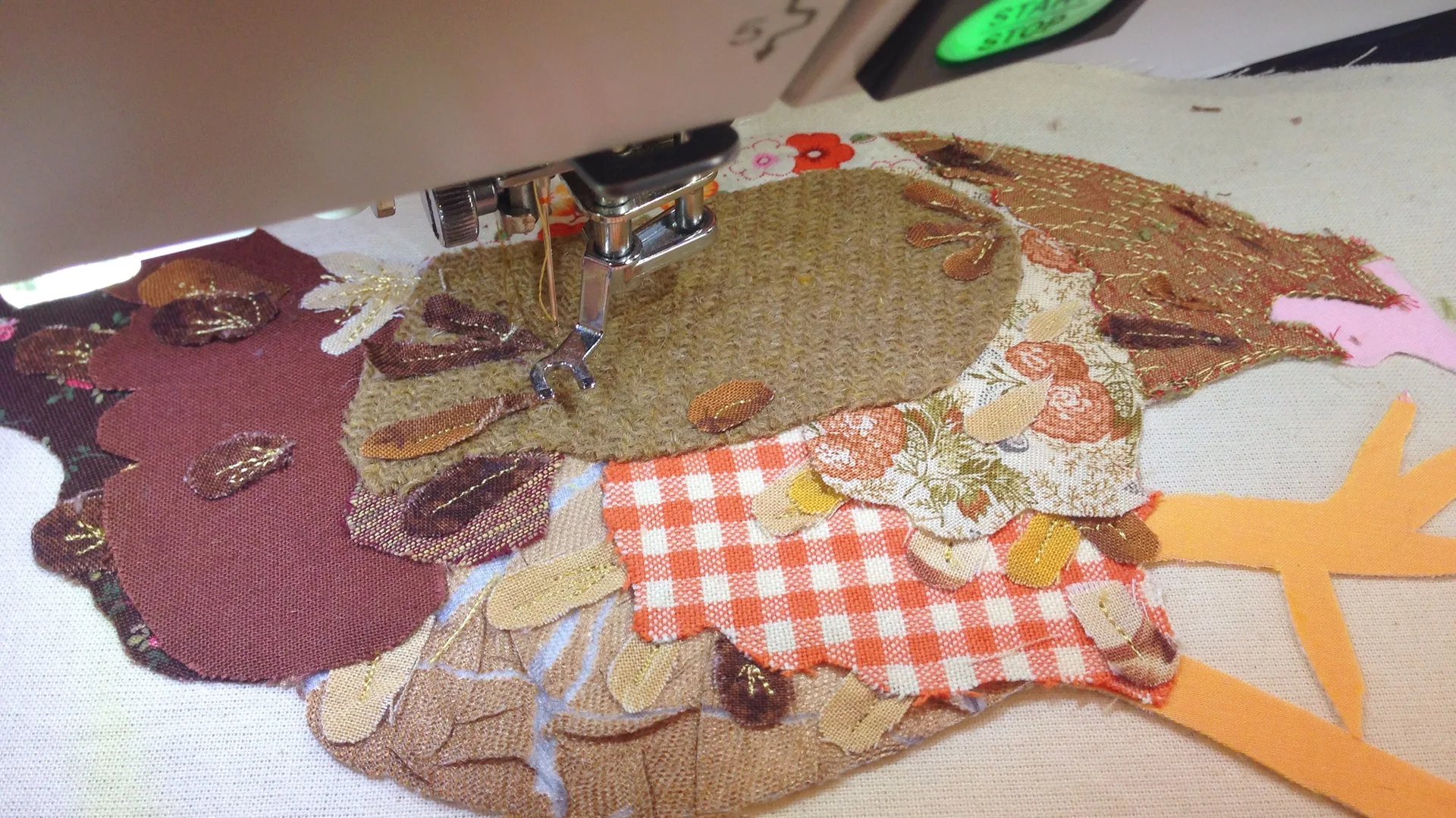
Katie Essam
Katie Essam uses a Janome Horizon Memory Craft 7700 for free motion embroidery, with the feed dogs down. Katie explains: ‘Its needle up/down button is great, but the best bit has to be the thread cutting function – the sound it makes as it cuts is so satisfying!’
Katie also still uses her very first machine, a Bernina Activa 220.
For stitching large works, she recommends using a heavyweight machine, as it is stable and smooth to work on. The downside (or perhaps the upside!) is that it’s a bit of a workout if you want to take it out and about to in-person workshops.
“The Janome 7700 has a long arm and large base, perfect for stitching large bits of fabric.”
Katie Essam, Textile artist
Katie advises that most machines can do free machine embroidery with minimal adjustments so you may not have to splash out for a brand new machine. You can use any machine, as long as the feed dogs can be lowered (or a needle plate cover can be placed on top of them).
You’ll need to source a free motion embroidery foot with either a C-shape (open toe), which helps you see what you are doing, or an O-shape (closed toe), which is best for couching and textural stitching.
Katie Essam: ‘I learned to sew on my Mum’s Bernina from the 70s. The older machines were built to last and without the digital bits, it seems like less can go wrong. The weight of the old style metal cases help with stability.
‘I’m a fan of weighty machines. With free motion embroidery, it’s best to have the machine as still as possible while you work – a heavy machine and a sturdy work surface help to achieve this. However, if you need (or already have) a lightweight portable machine, it can also be used for free machine embroidery.
‘If you are looking for a new machine, a brilliant feature to look out for is the thread cutting function, as well as a good sized working area. A sewing table attachment can be useful, although they can make changing a front loading bobbin a little tricky.’
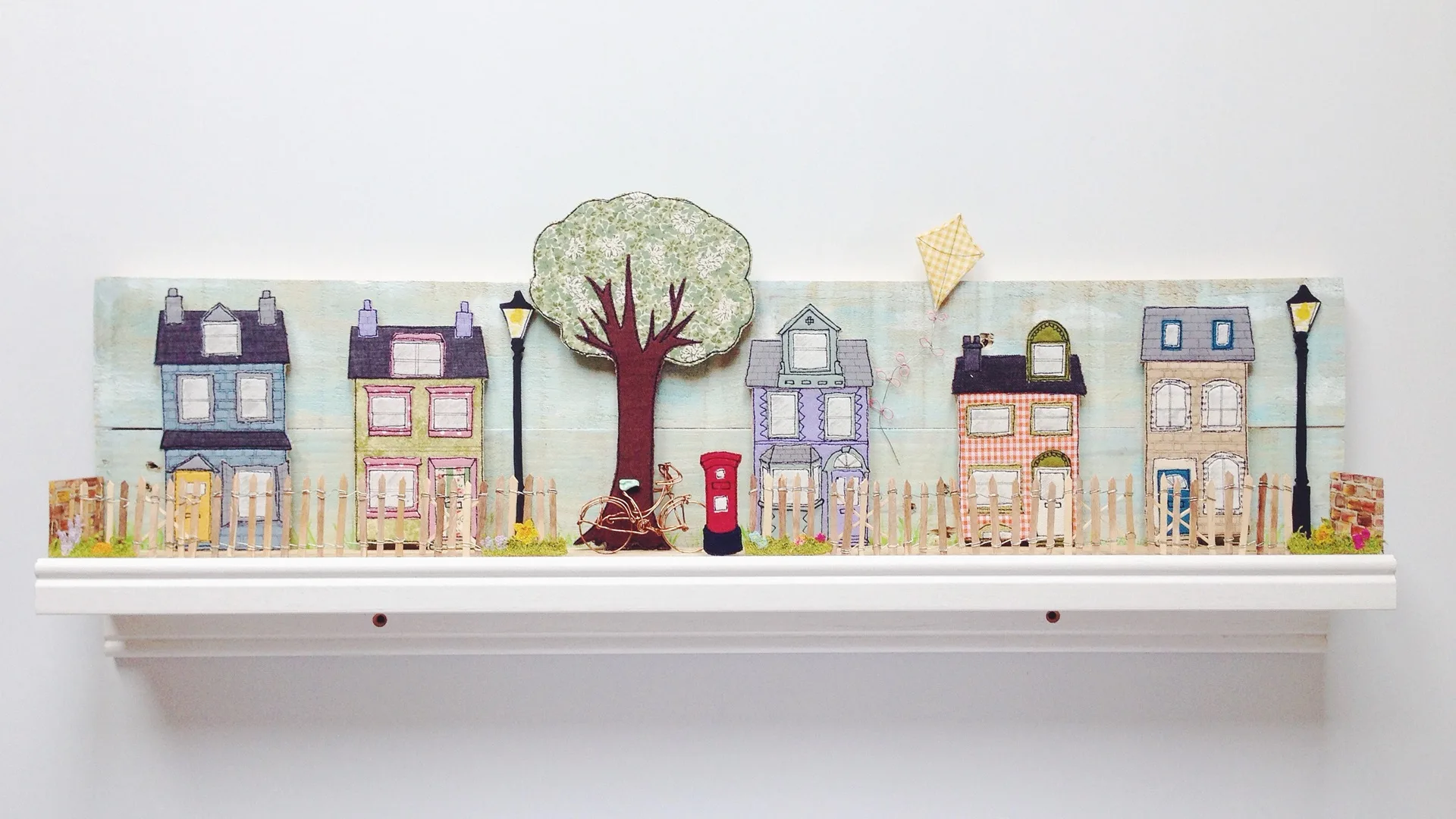
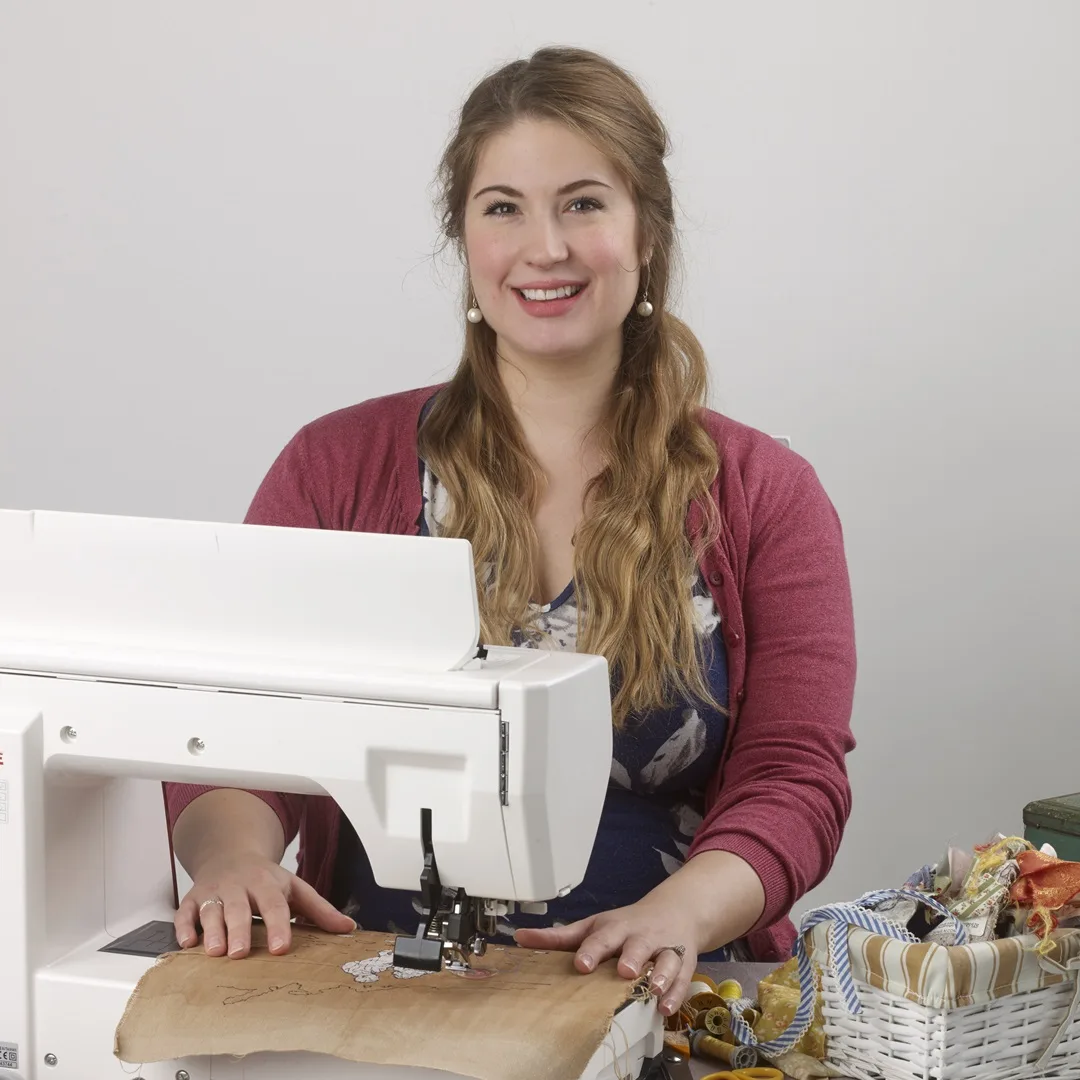
Katie Essam’s useful tips
Katie: ‘If you do a lot of free motion embroidery, don’t touch the tension! I learnt this the hard way. And when stitching through lots of layers of fabric, change the needle regularly and go for a thick heavy duty needle, which won’t bend or snap so easily.
‘Make sure you are as comfortable as possible, that your table and chair are at the right height and distance apart, and that your machine and pedal are the right distance away from you – your forearms should rest comfortably on the table.’
Katie Essam is a mixed media textile artist based in Bexhill, UK.
Katie loves the freedom and enjoyment of experimenting with different media. She is the author of Free Motion Embroidery: Creating Textile Art with Layered Fabric & Stitch (2022). ISBN 9781800920484
Website: katie-essam.co.uk
Instagram: @katiejeany
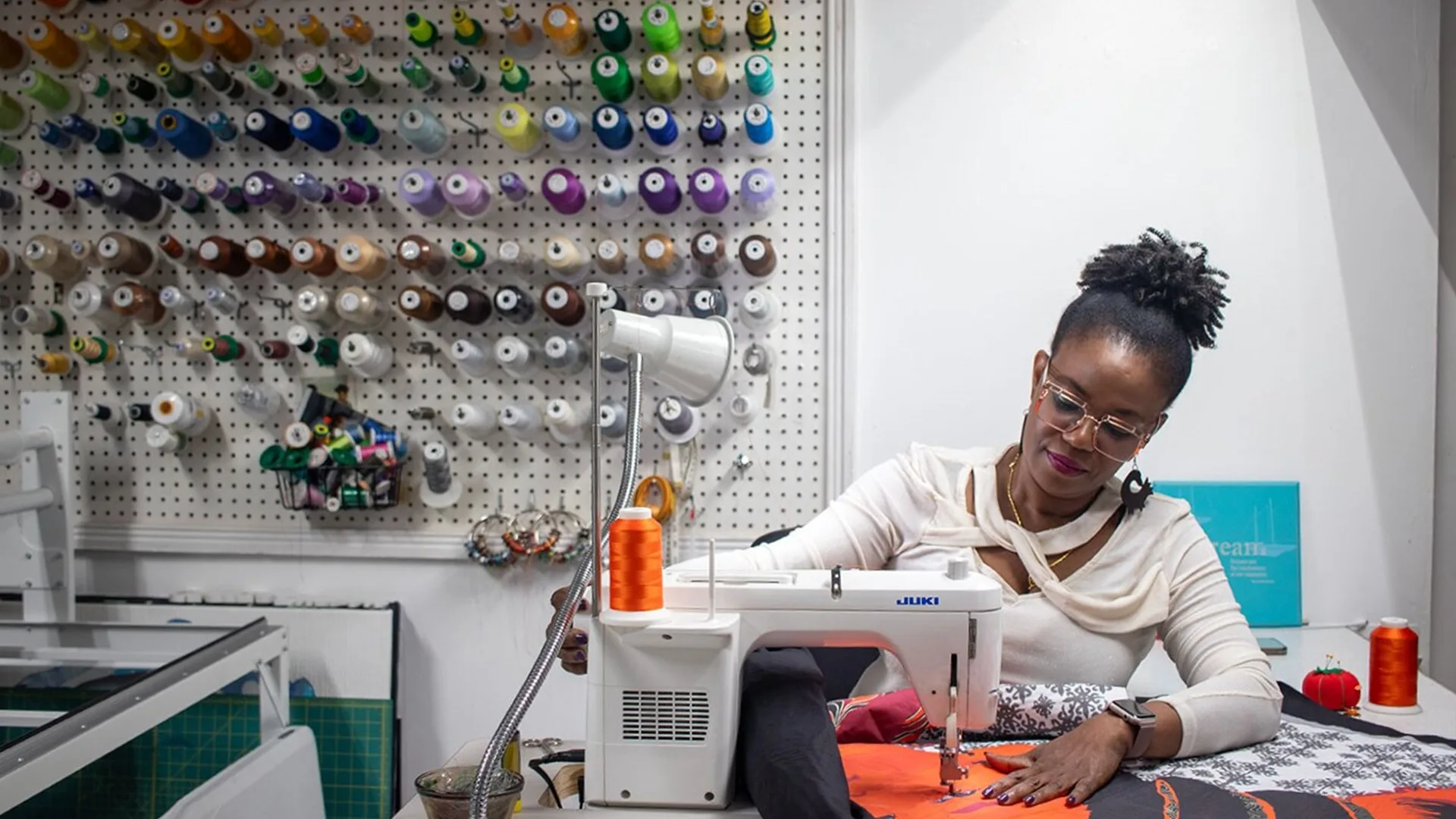
Clara Nartey
Clara Nartey uses a range of techniques to make her art quilts, including embroidery, quilting, appliqué, digital painting and digital printing. All the fancy stitches that many sewing machines offer were not important to her style of embroidery.
She currently uses a domestic sewing machine by JUKI TL-2010Q and a Moxie mid-arm quilting machine by Handiquilter. Her domestic machine allows her to complete detailed sewing and precision embroidery work, and the mid-arm machine is for quilting and overall embroidery.
Clara Nartey: ‘The JUKI 2010q is a workhorse. The machine I had before this was a computerised embroidery machine, but I needed a machine that gives me the flexibility to use it as an intuitive drawing tool. With this machine, I can take control of the direction of the stitching the way that I want it.’
Having found it difficult to create larger art quilts, Clara acquired a mid-arm sewing machine, which would help her manoeuvre heavier and larger pieces. The mid-arm machine has a 38cm (15″) throat space giving her much more room to work.
“I went for a simple straight-stitch sewing machine with lots of power to support the heavy stitching I do.”
Clara Nartey, Textile artist
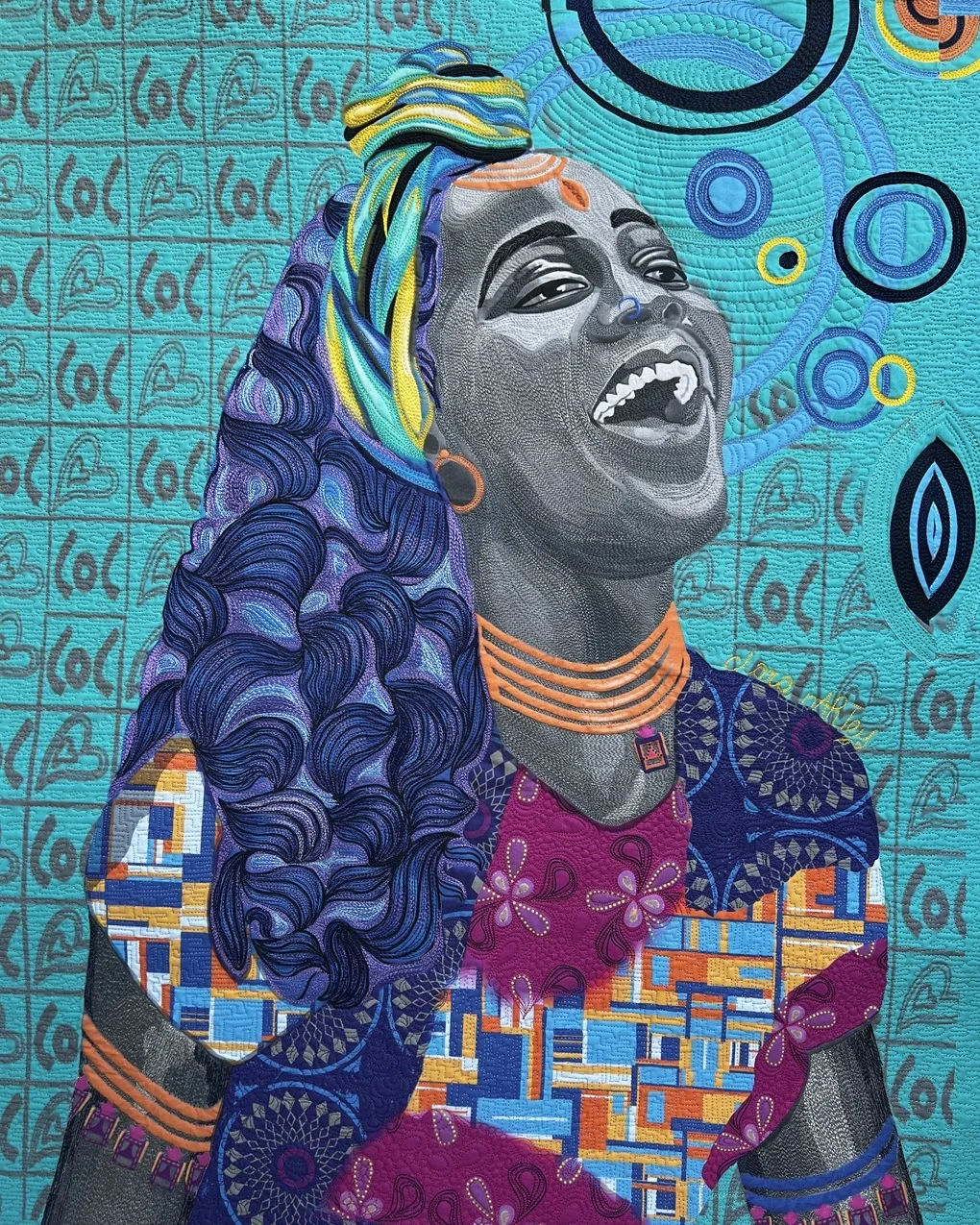
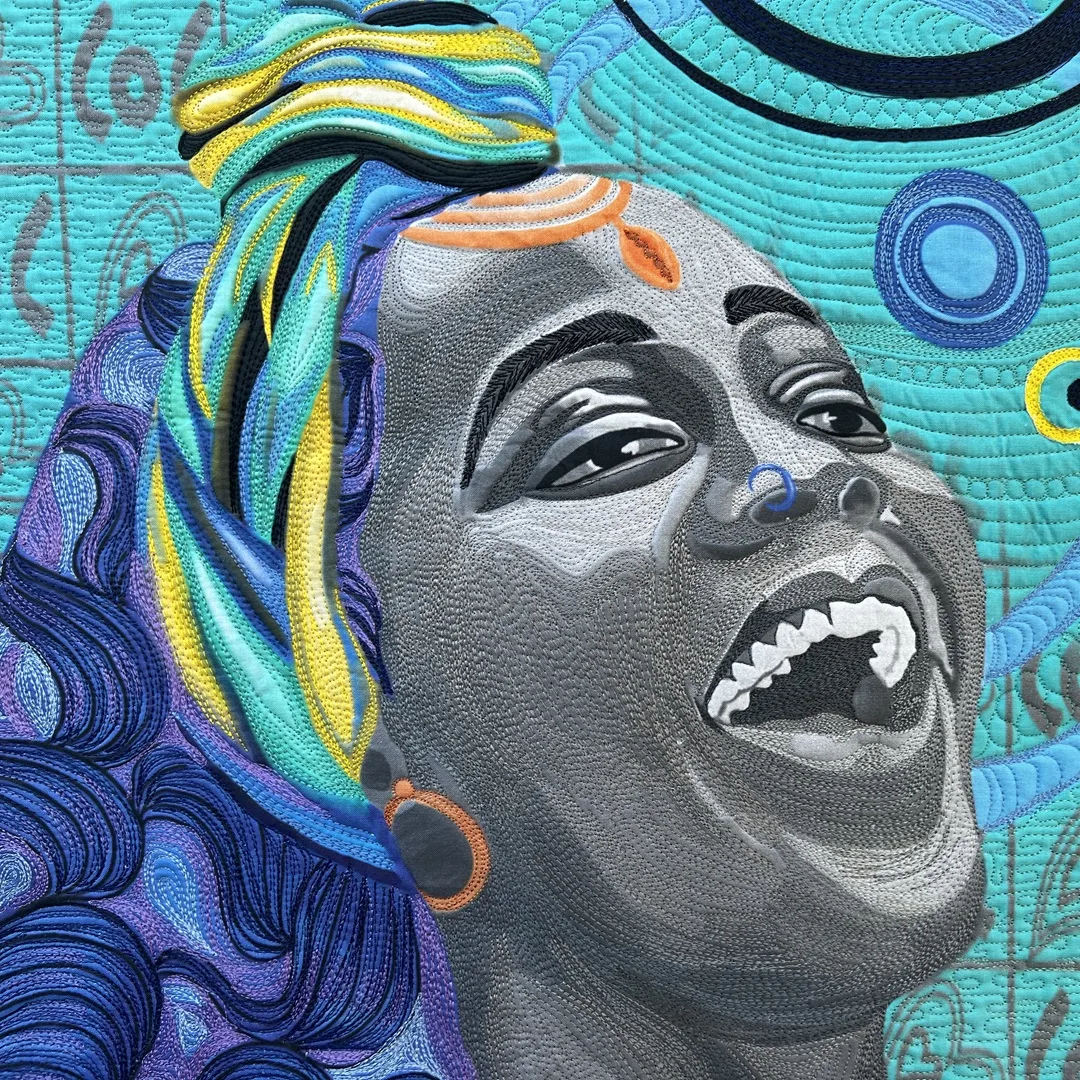
Clara Nartey’s useful tips
Clara: ‘My recommendation for getting a sewing machine for embroidery is to focus on what you need. What does your style of embroidery require? My style of free motion embroidery requires two things: the ability to drop my feed dogs and to do straight stitches.
‘Also, when you’re buying a sewing machine, look for one where you have local support. Machines break down sometimes and it’s frustrating not to have a service company nearby to fix your machine for you.’
Clara Nartey is based in Connecticut, USA.
Clara tells visual stories of Black women inspired by her African heritage and her work is held in private and public collections including at Yale University. She is the author of Drawn with Threads: What a textile art exhibition can teach us about our creative potential (2019). ISBN 9781733250207
Artist website: ClaraNartey.com
Instagram: @ClaraNartey
Facebook: ClaraNarteyArt
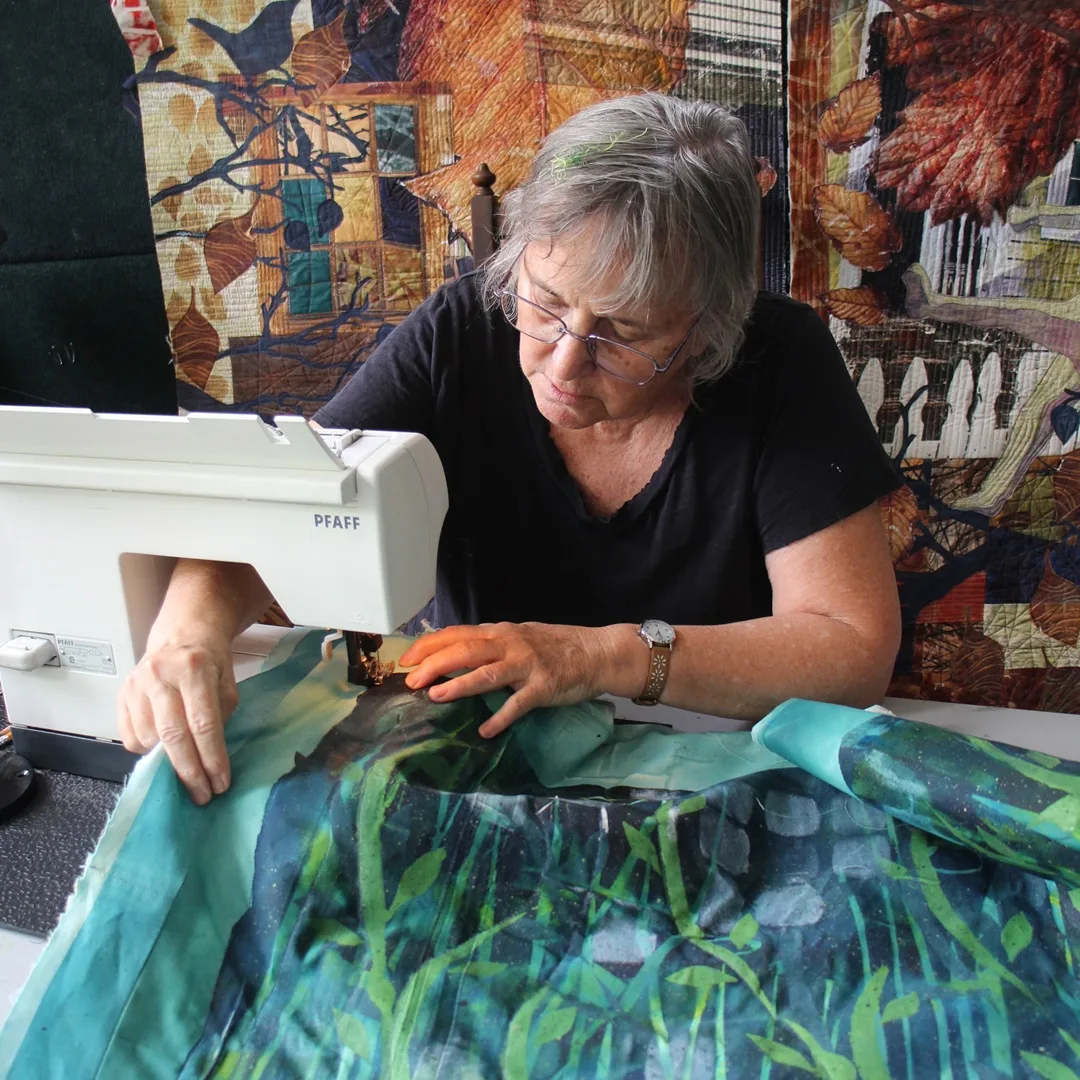
Bobbi Baugh
Bobbi Baugh creates collaged textile artworks, using original painted and hand printed fabrics, collaged with glue and then stitched. She works most projects in smaller sections, then joins these together using machine-sewn seams.
You might be surprised to hear that both of the portable sewing machines that Bobbi uses are over 30 years old. One is a Pfaff Hobbymatic 875 and the other a Pfaff Select 1536, and she uses both for all her construction and quilting.
Bobbi Baugh: ‘I purchased the first one when I had my first home, wanted to sew drapes, and needed to upgrade from the Singer I’d used since high school. I had never heard of art quilting at the time and it was not a well-researched purchase. I just told the salesperson I needed to sew through heavy fabrics without the timing and tension going haywire.
‘I was told that the Pfaff machines have a good motor, almost never require adjustments to the tension, and switch readily from one fabric type to another – that has proven to be true. Like my car, which is over 20 years old, I hope these two sewing machines keep chugging along for me forever.’
“It suits my temperament and philosophy of artmaking to use materials and equipment that are as simple as possible.”
Bobbi Baugh, Textile artist
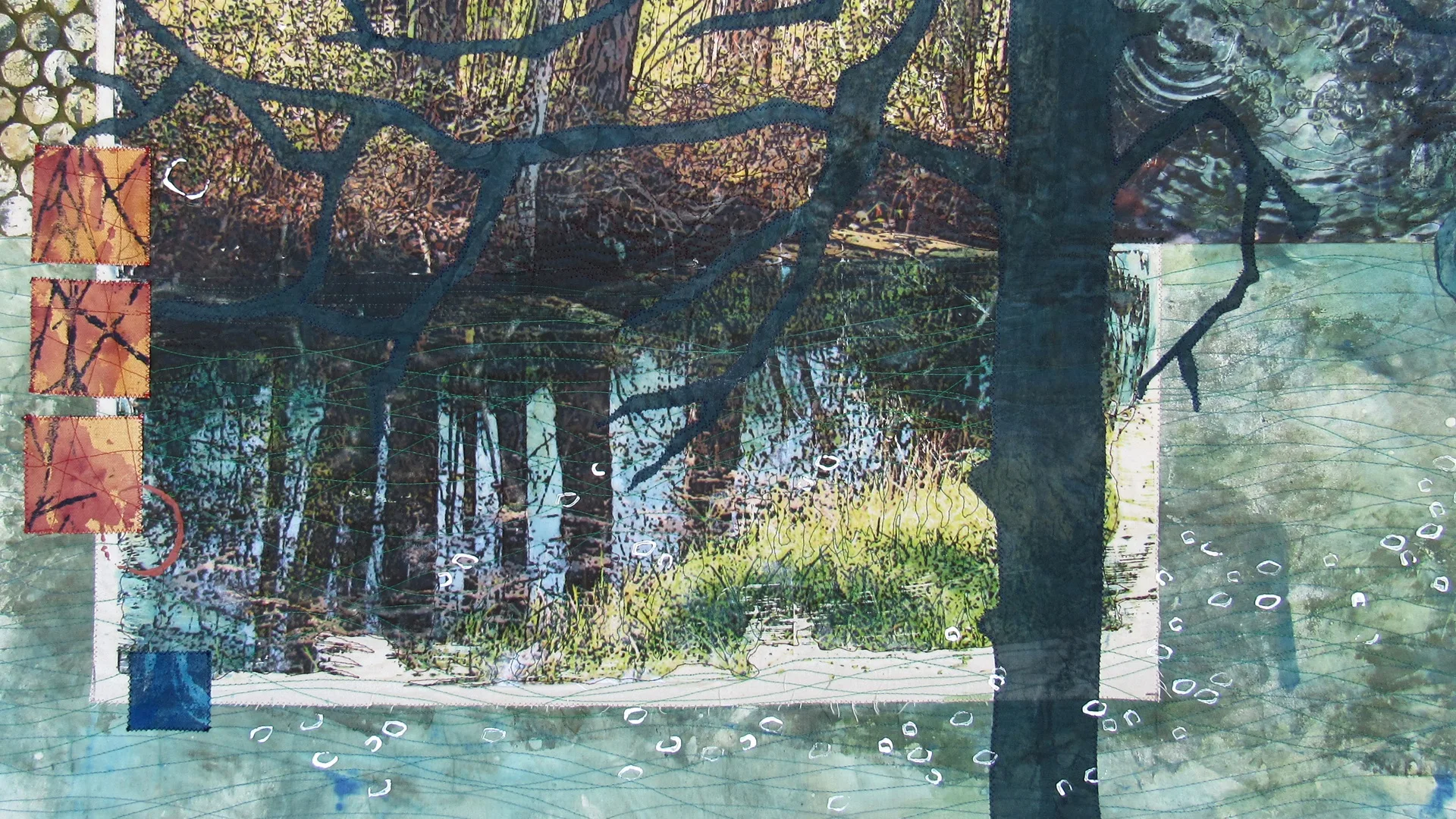
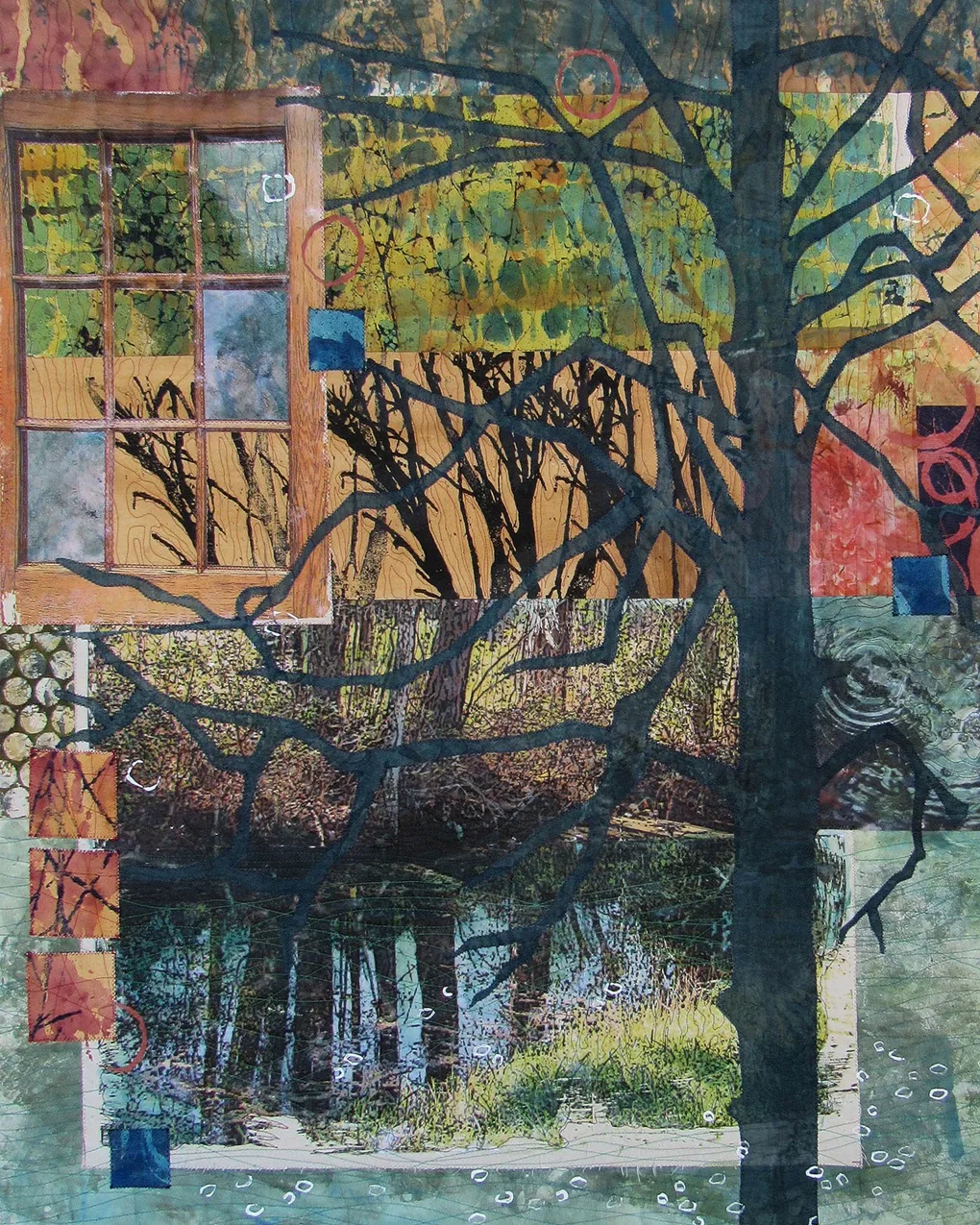
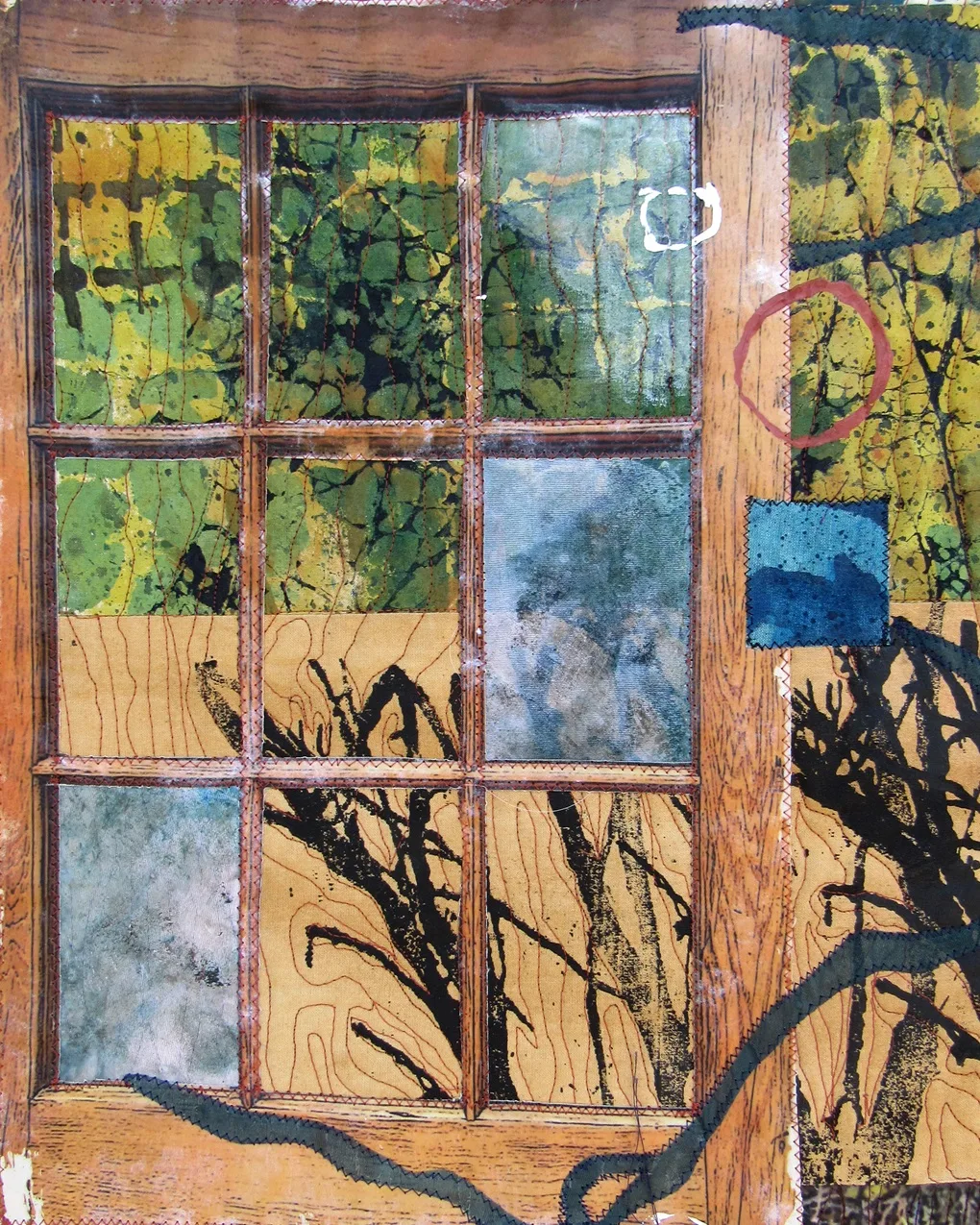
Bobbi Baugh’s useful tips
Bobbi: ‘To take care of your machine, take it for a service and cleaning at least once a year. When I tell my very reliable and faithful local repair serviceman the kinds of fabrics I sew, he just shakes his head and scolds: “Paint and glue on fabric! Really?”. But he keeps my machines running smoothly.’
Bobbi Baugh is a mixed media textile artist based in DeLand, Florida, USA.
In 2023-24, Bobbi’s work was shown in six SAQA Global Exhibitions, at Q=A=Q at the Schweinfurth Art Center, Art Quilt Elements in Wayne, Pennsylvania, and at numerous other regional and national exhibitions.
Website: bobbibaughstudio.com
Facebook: bobbibaughart
Instagram: @bobbibaughart
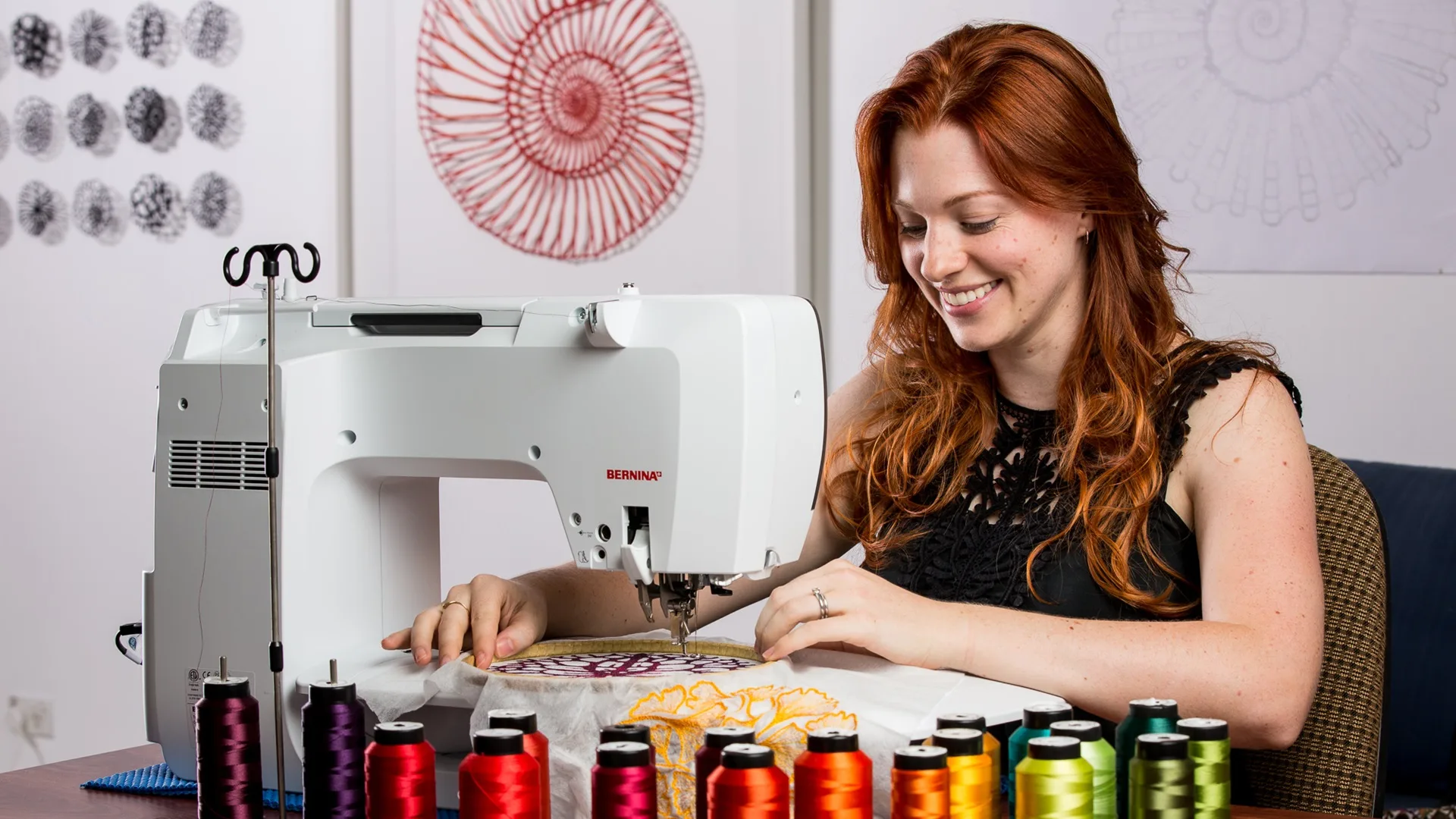
Meredith Woolnough
Meredith Woolnough uses free motion embroidery in combination with soluble fabric to create her ethereal sculptures inspired by nature. She uses a Bernina Q20 for most of her work, switching to a regular domestic machine for zigzag stitches or if she’s travelling or teaching a workshop.
She finds the Bernina a comfortable machine to work on, but she stresses that you only need a regular domestic machine for free machine embroidery. Several years ago she wrote a post on her blog explaining why she mostly uses her Bernina Q20.
As for buying a machine, Meredith recommends: ‘Purchase the absolute best machine you can afford at the time. View a sewing machine as a long term investment. Second hand machines can be a good option if your budget is tight.’
“Get a good machine, take good care of it and it will serve you faithfully for a lifetime.”
Meredith Woolnough, Textile artist
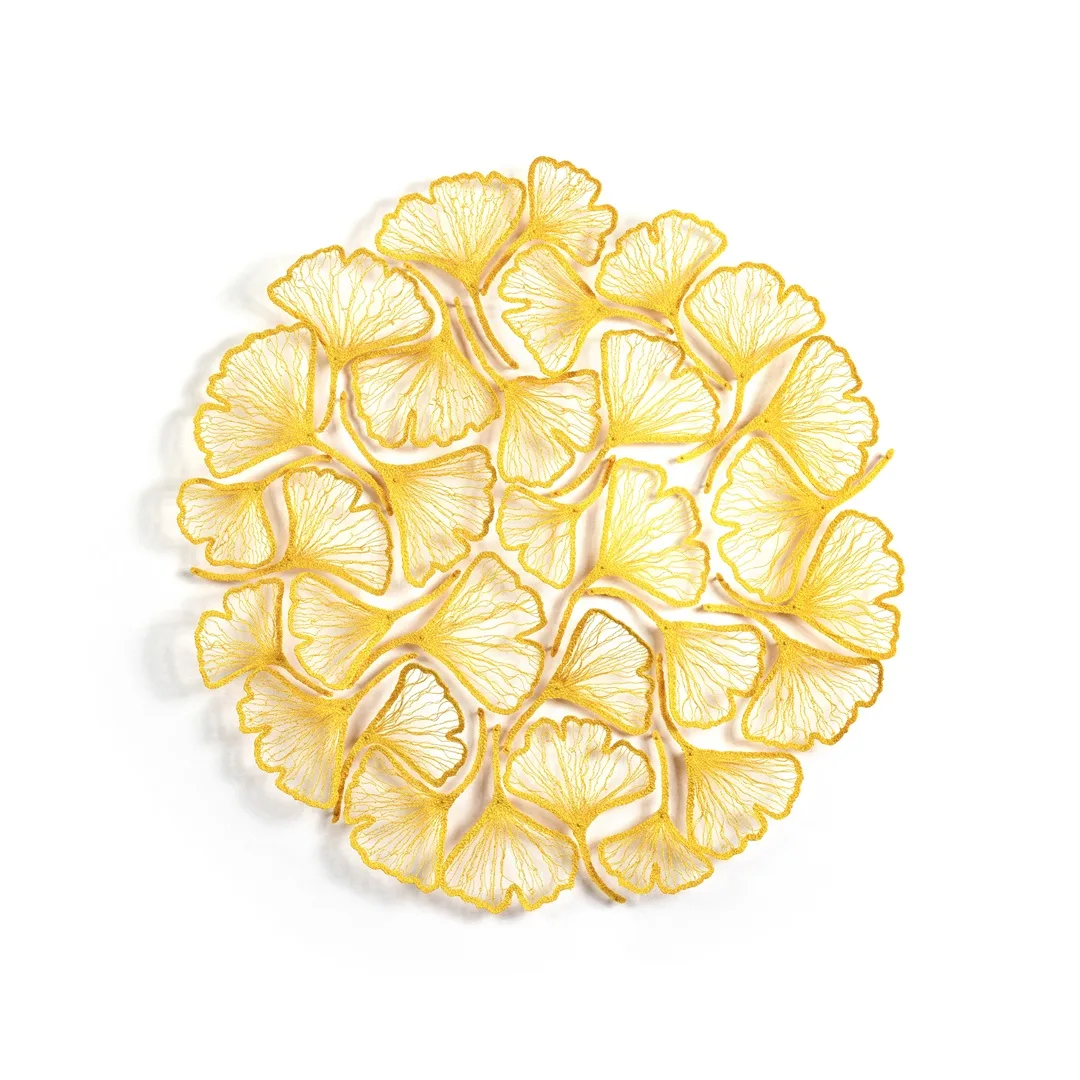
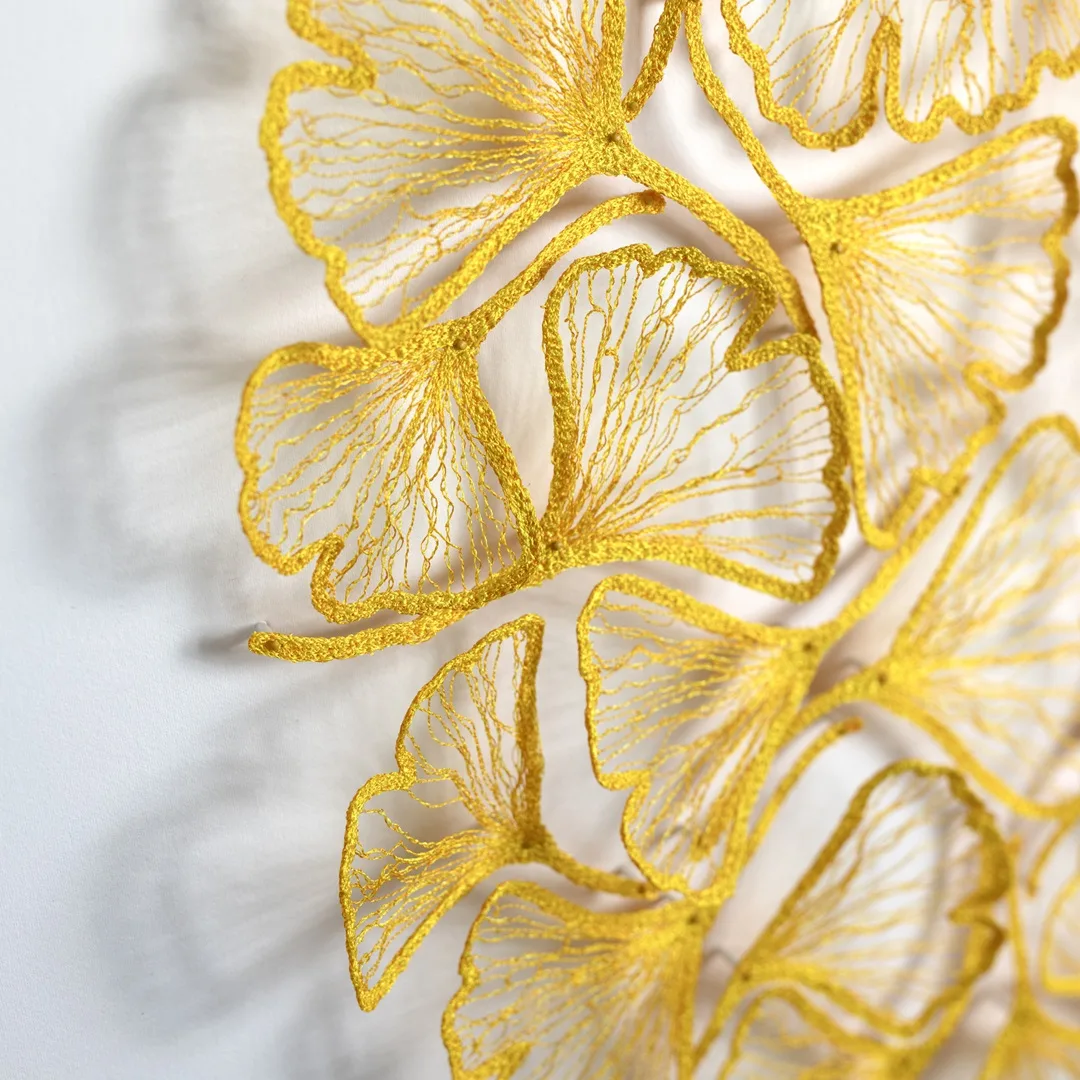
Meredith Woolnough’s useful tips
Meredith Woolnough: ‘Clean your machine regularly. For basic machine maintenance that you can easily do yourself, a few drops of strategically placed oil and a quick brush of the bobbin compartment is key. Your sewing machine manual or a quick Google search will tell you what you need to do – so no excuses! Your machine will thank you for it.
‘Secondly, make sure you have the right needle for the job. Fresh needles can fix a lot of stitching problems but, in my opinion, choosing the right needle from the beginning is even more important.
‘Choose a needle to suit the type of work you are doing, in a size to suit the thickness of your thread. I work with standard weight machine embroidery thread and find that a size 90 Jeans needle (sharps needle) works best for freehand embroidery on water soluble fabric.’
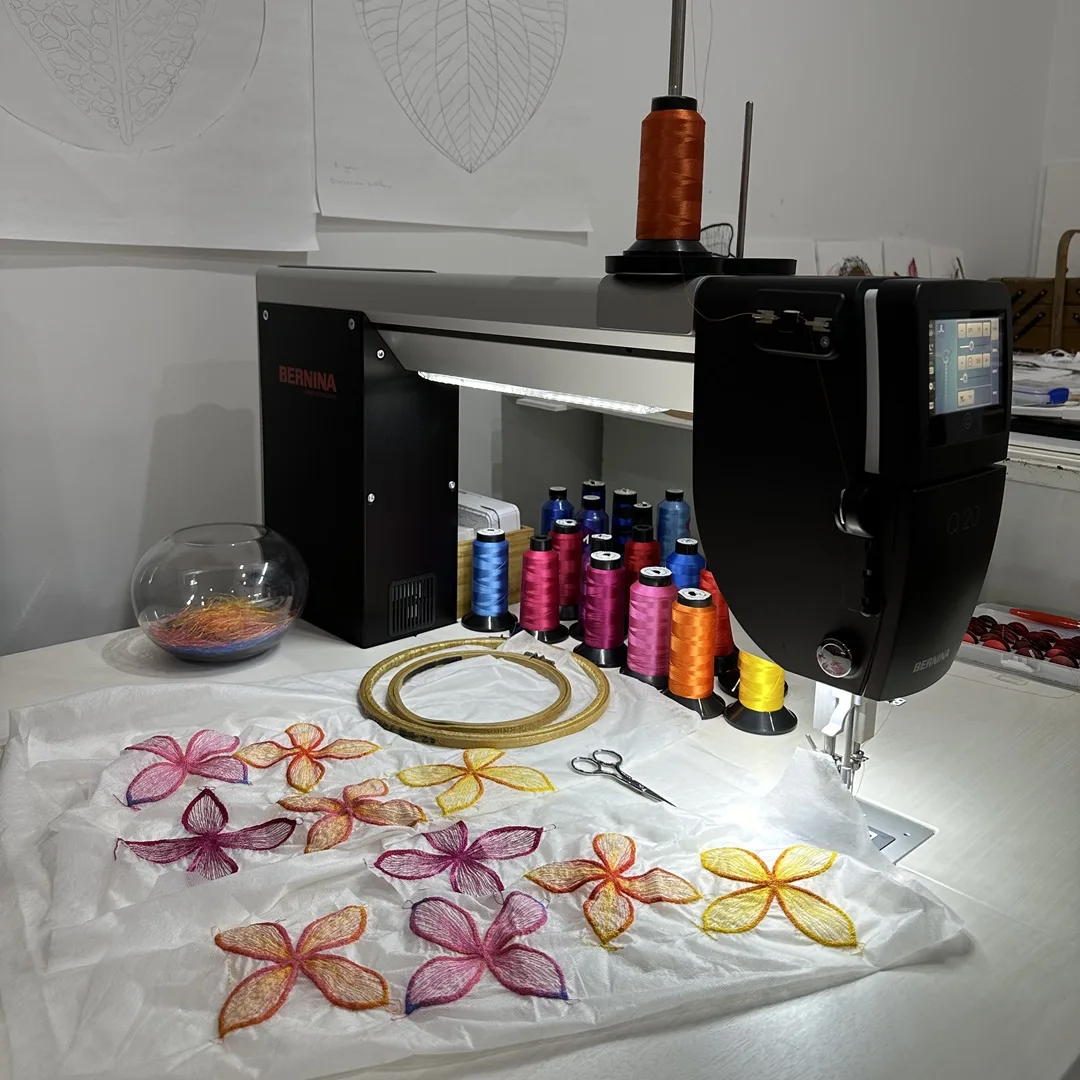
Meredith Woolnough is based in Newcastle, Australia, and is known for her sculptural embroideries inspired by nature.
Meredith has exhibited widely and her work is held in collections in Australia. She is the author of Organic Embroidery (2018), ISBN 9780764356131.
Website: meredithwoolnough.com.au
Facebook: meredithwoolnoughartist
Instagram: @meredithwoolnough
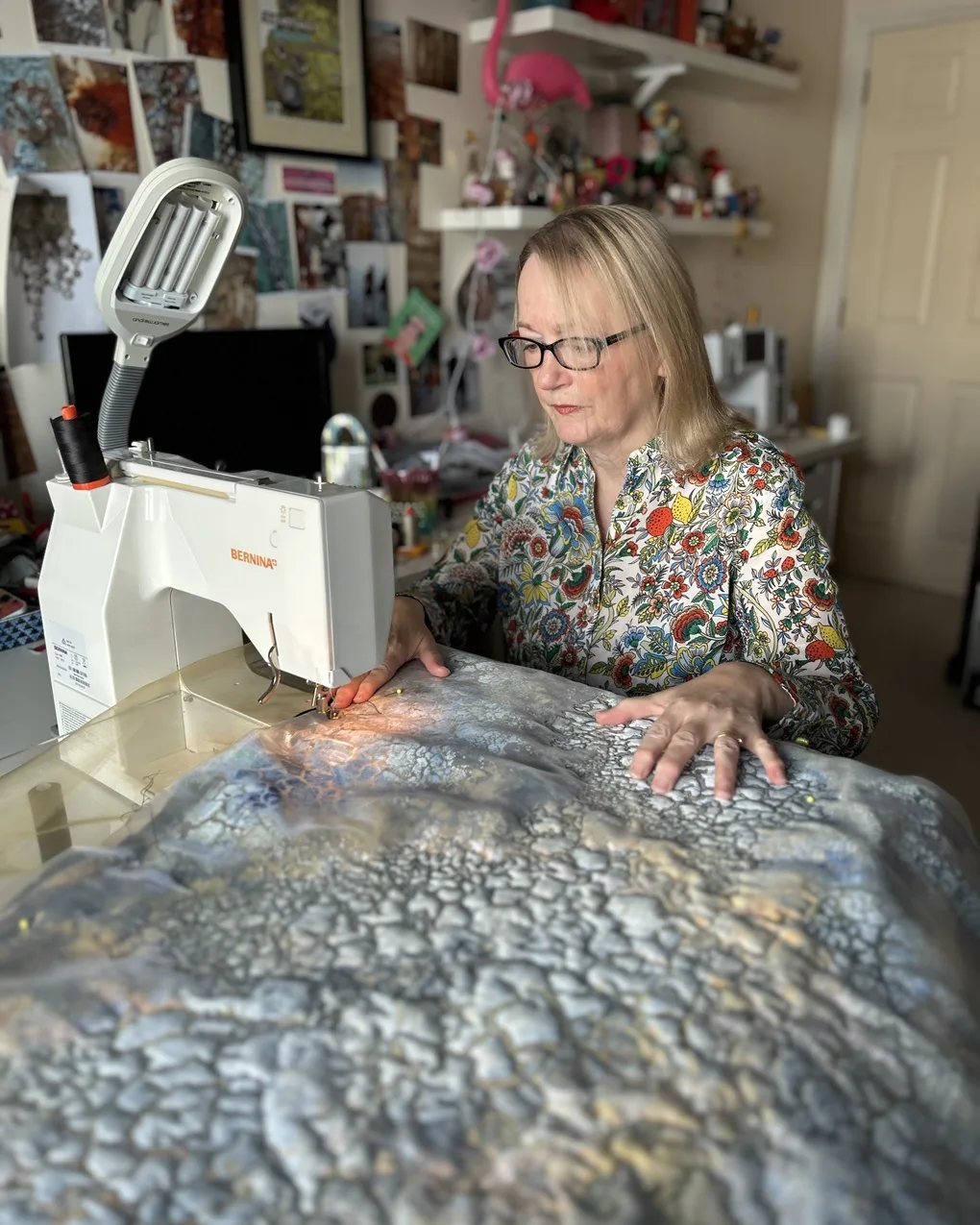
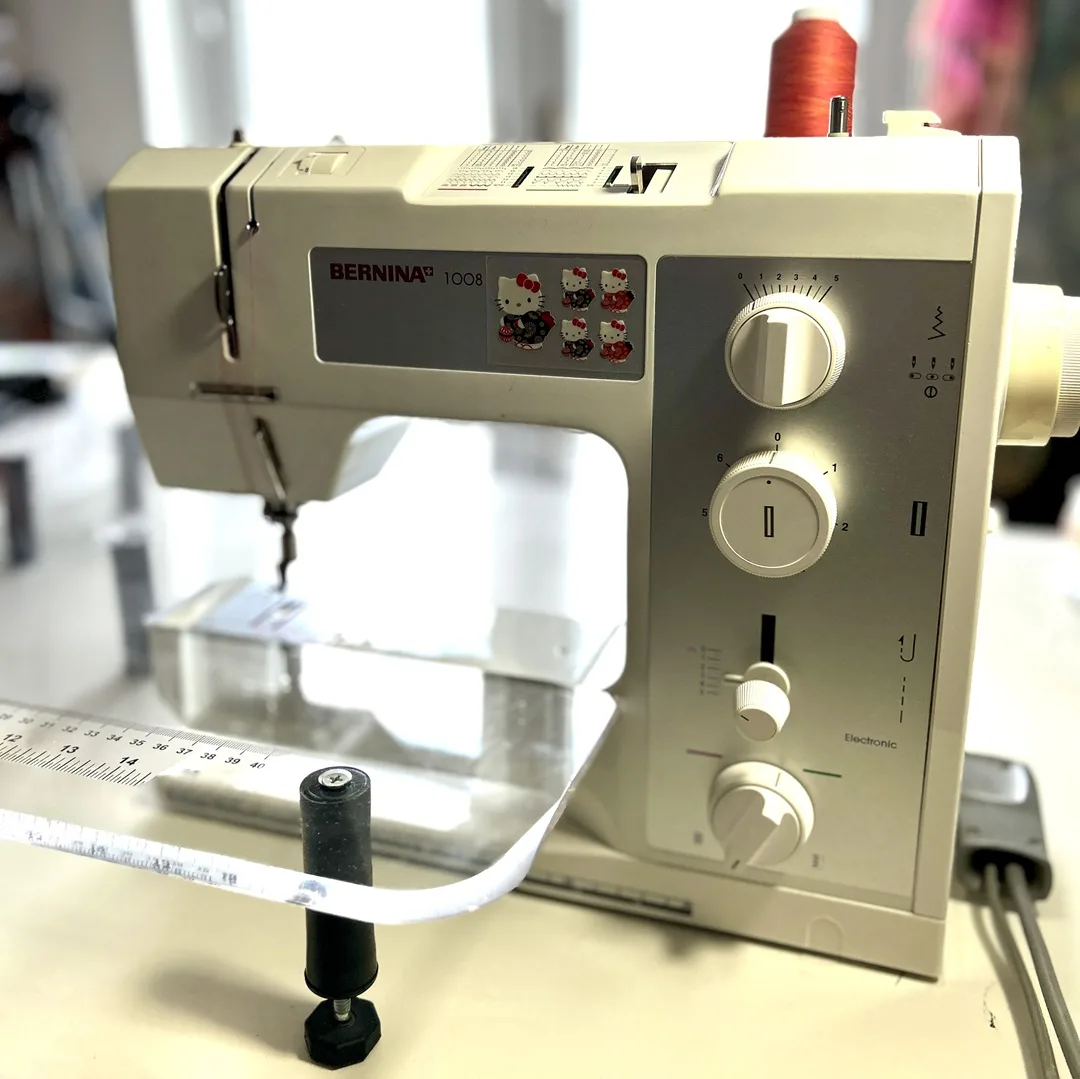
Sue Hotchkis
The Bernina 1008 is the machine Sue Hotchkis uses the most to create her artwork. She also has a Bernina 730e, which is a computerised sewing machine with an embroidery unit attachment.
Sue Hotchkis: ‘The 1008 is sometimes referred to as the workhorse because it’s very strong and can take a lot of rough treatment because it’s not computerised. There are no fancy needle threading options. With my artwork, I often sew through several layers of fabric and it doesn’t struggle.
‘The Bernina 730e lets me draw my own design on the laptop and then turn it into a stitched design. This model is old now. I bought it at a good price when a newer model came out.’
“The Bernina 1008 is a very straightforward sewing machine and it’s great for free motion stitching.”
Sue Hotchkis, Textile artist
‘The Bernina 1008 is great for free motion stitching and has interchangeable feet – my favourites are the cording foot for creating cords of several strands of thread wrapped in satin stitch, and the tailor-tacking foot which creates a decorative loopy surface stitch. If you want to make creative textiles with unusual materials then this type of Bernina is ideal.’
Sue first encountered Bernina sewing machines while studying embroidery at university. She bought her first Bernina, a 1001 model, over 30 years ago – and it still works! Sue found a secondhand one on sale recently for the same price she originally paid in the 1990s.
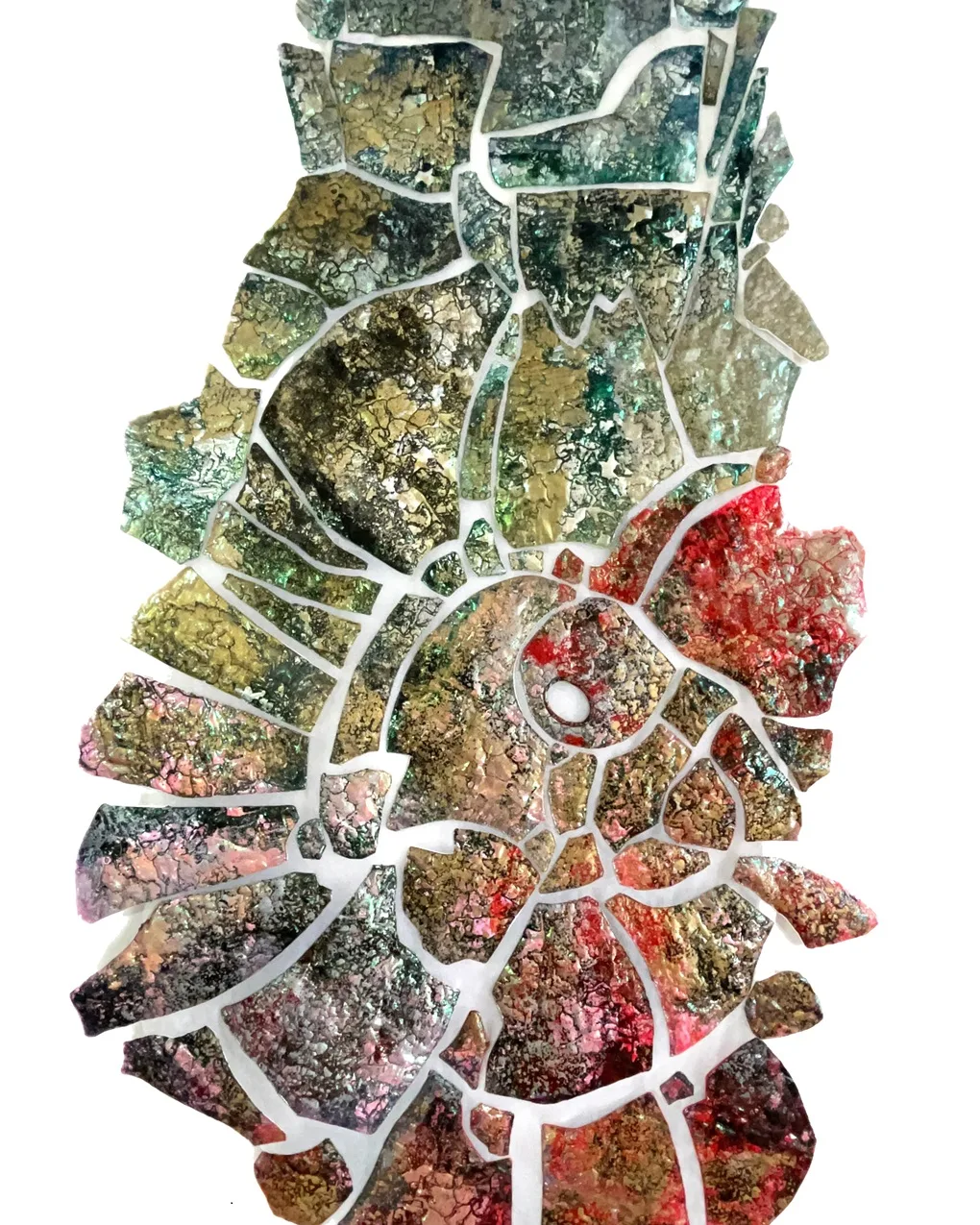
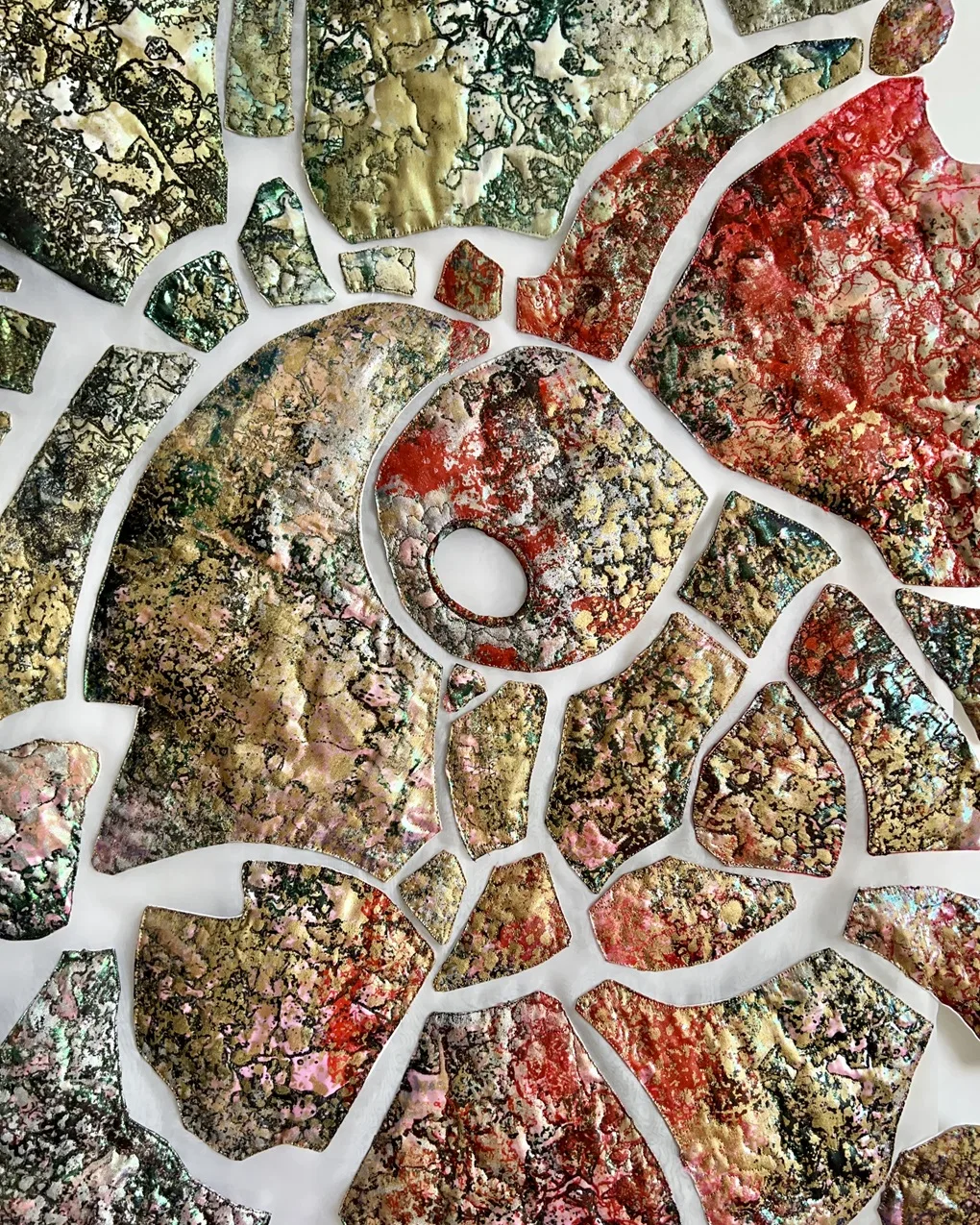
Sue Hotchkis’ useful tips
Sue uses her machine with a custom Sew Steady extension table, which helps when working on a large artwork. She explains: ‘The fabric doesn’t drag and pull on the needle when stitching and the table takes the weight and allows the fabric to flow’.
Sue Hotchkis is based in the Highlands of Scotland, UK and creates printed and stitched abstract wall art.
She was awarded the Silver Medal at the 12th Scythia Textile Biennial in 2018, and an Award for Excellence at the 11th Lausanne to Beijing International Fiber Art Biennial in 2021. She is a member of QuiltArt and Edge Textiles Scotland.
Website: suehotchkis.com
Facebook: SueHotchkisTextiles
Instagram: @suehotchkis
Glossary
- Bobbin – A small spool of thread that sits inside the machine to supply the bottom thread.
- Extension table – An accessory that attaches to the machine to provide a wider working area, useful when working with large pieces of fabric or a large embroidery hoop.
- Feed dogs – The teeth located under the presser foot that evenly feed the fabric through the machine.
- Free motion embroidery – Where the stitching is controlled freehand, like a drawing, and the feed dogs are lowered or covered so the fabric glides easily in any direction under the needle.
- Free motion embroidery foot – A specialised presser foot that allows the fabric to glide around for freehand embroidery work.
- Long arm machine – A sewing machine and frame, with an extra large working area of over 45cm (18″) and rollers to help manipulate large quilts.
- Mid arm machine – A sewing machine with a wide throat space of 30cm – 45cm (12″ – 18″).
- Needle plate – The metal plate through which the needle and bobbin thread pass during stitching.
- Needle plate cover – A plastic cover that sits on top of the needle plate, allowing free motion embroidery in a more basic machine where the feed dogs cannot be dropped.
- Presser foot – A metal foot that presses the fabric down to the needle plate during sewing.
- Throat space – The working area to the right of the needle, between the main body of the machine and the needle plate.
- Zigzag stitch – An automatic stitch setting for creating z-shaped stitches.
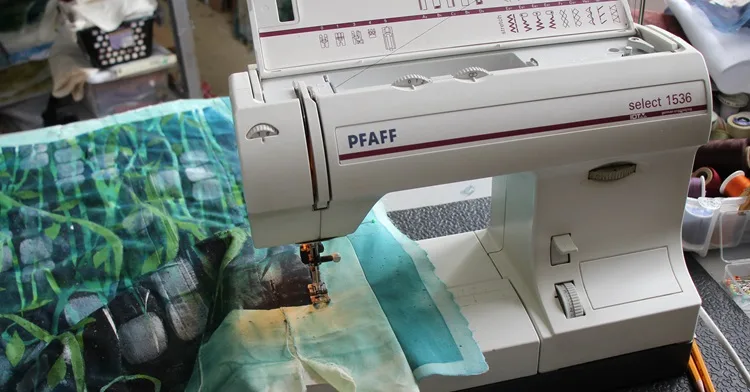
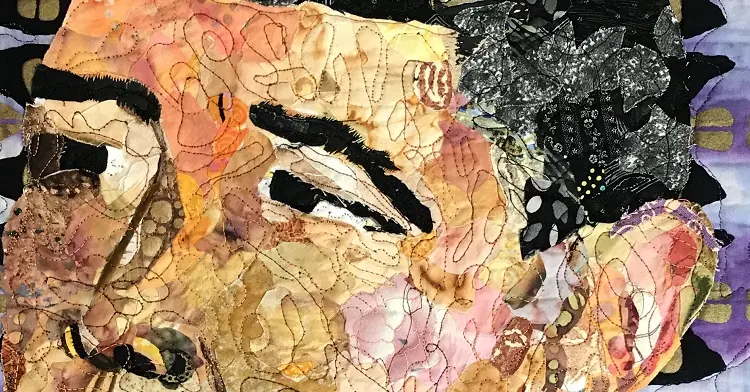
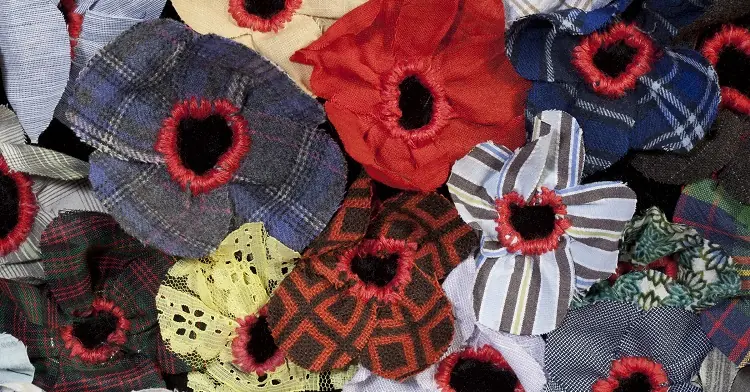
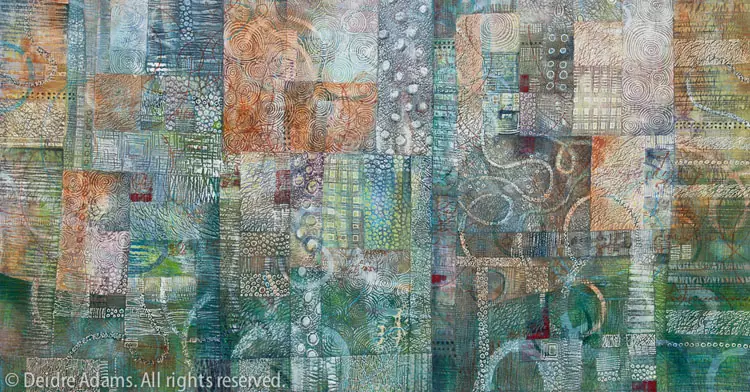
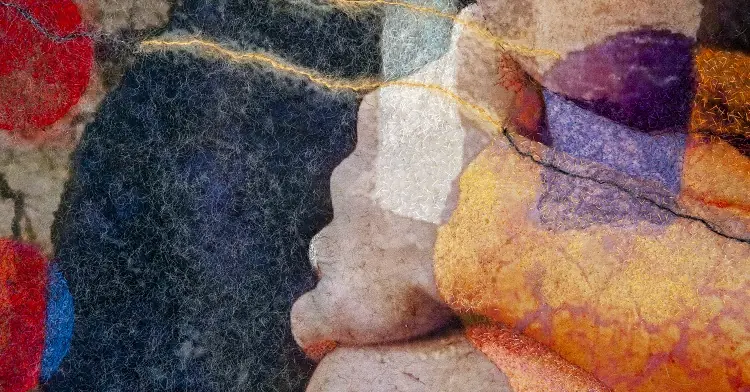
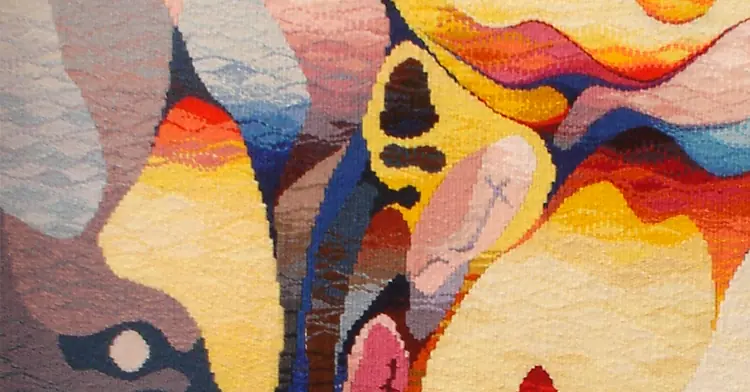
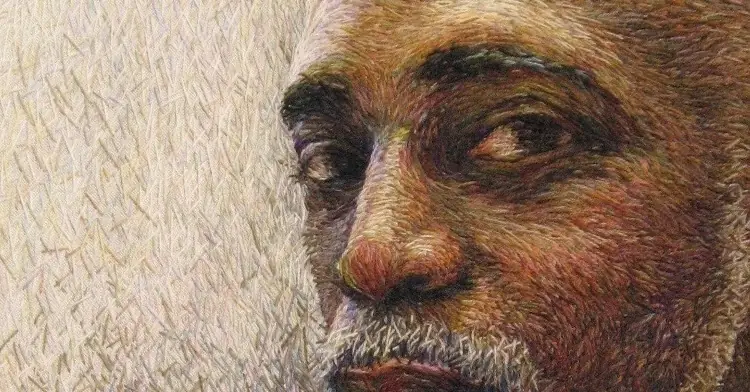
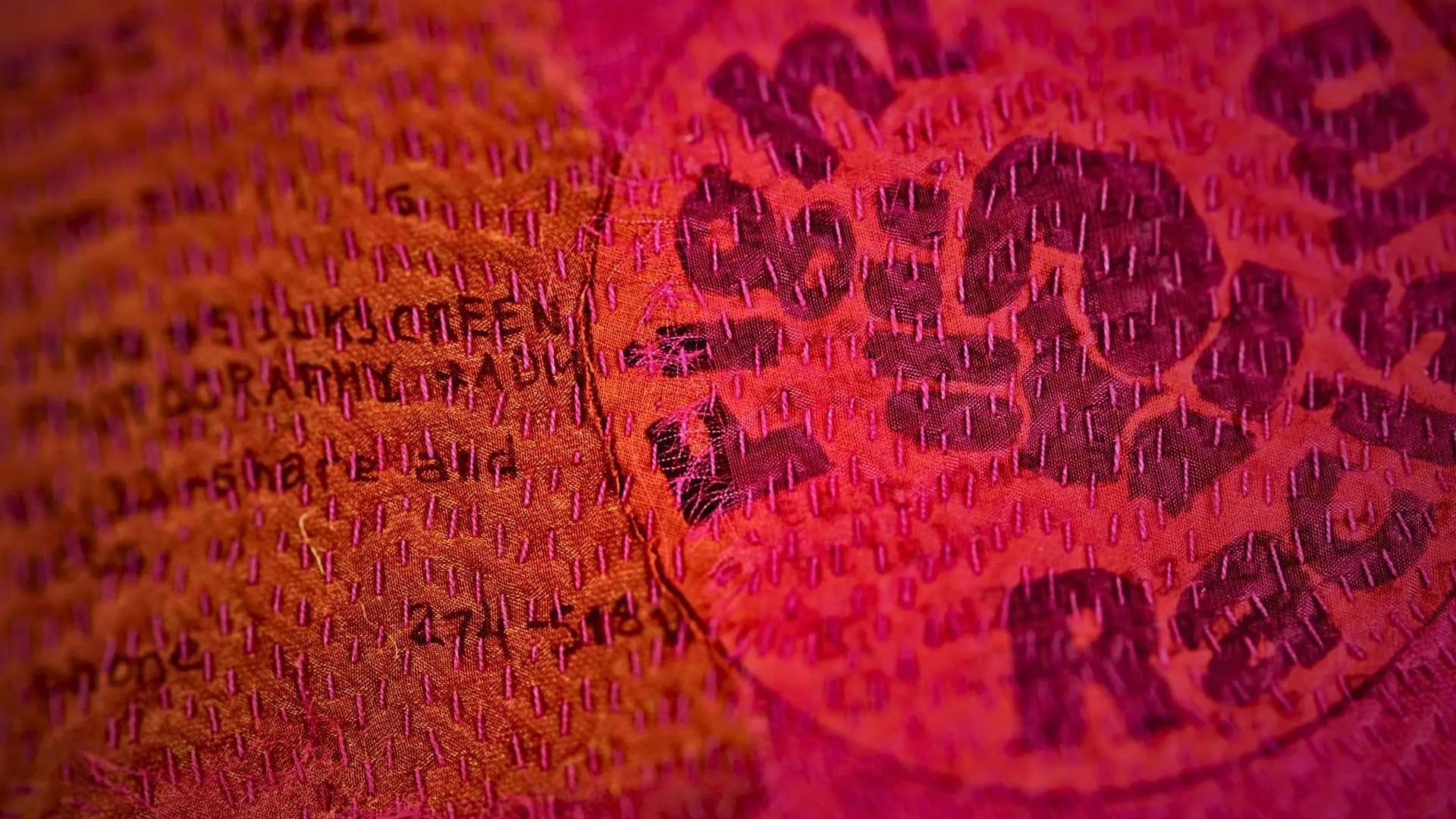
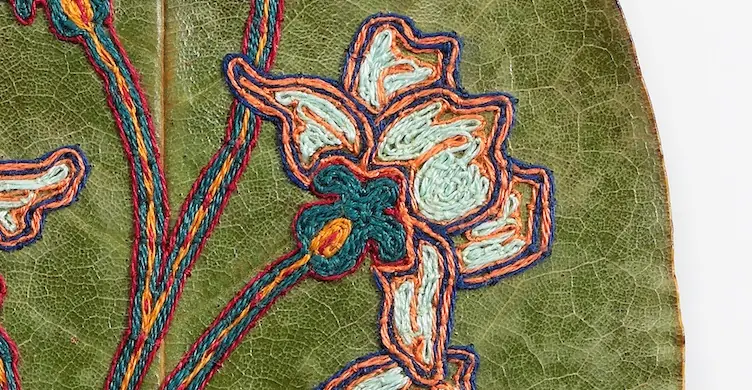
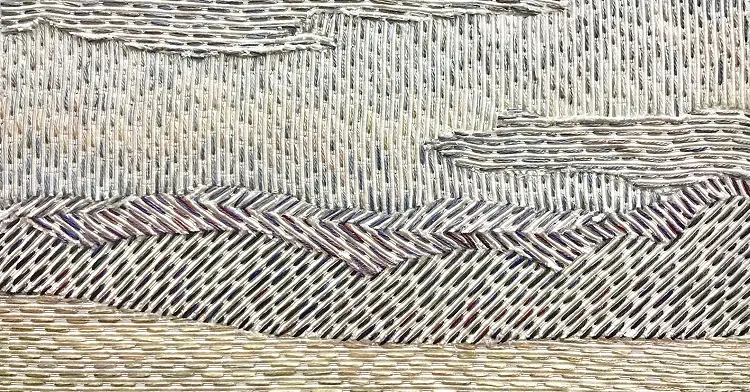
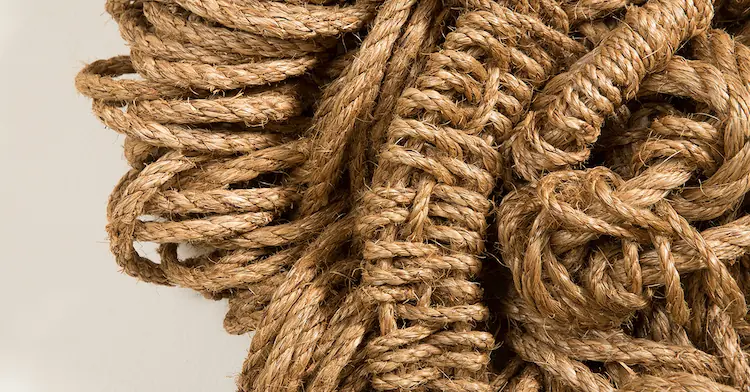
2 comments
Wendy Kasap
I have a Frister+Rossmann which must be over 40 years old and although small to look at is heavy duty and powerful, with simple but flexible features
Siân Goff
That’s amazing, Wendy. These machines were built to last!